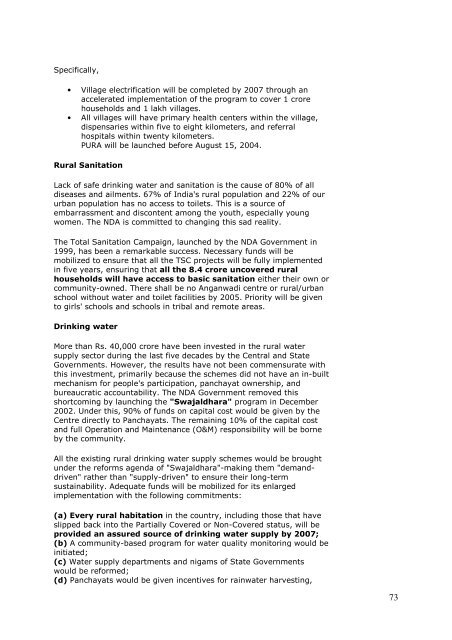Hindutva, Hindunasjonalisme og Bharatiya Janata Party En ...
Hindutva, Hindunasjonalisme og Bharatiya Janata Party En ...
Hindutva, Hindunasjonalisme og Bharatiya Janata Party En ...
Create successful ePaper yourself
Turn your PDF publications into a flip-book with our unique Google optimized e-Paper software.
Specifically,<br />
• Village electrification will be completed by 2007 through an<br />
accelerated implementation of the pr<strong>og</strong>ram to cover 1 crore<br />
households and 1 lakh villages.<br />
• All villages will have primary health centers within the village,<br />
dispensaries within five to eight kilometers, and referral<br />
hospitals within twenty kilometers.<br />
PURA will be launched before August 15, 2004.<br />
Rural Sanitation<br />
Lack of safe drinking water and sanitation is the cause of 80% of all<br />
diseases and ailments. 67% of India's rural population and 22% of our<br />
urban population has no access to toilets. This is a source of<br />
embarrassment and discontent among the youth, especially young<br />
women. The NDA is committed to changing this sad reality.<br />
The Total Sanitation Campaign, launched by the NDA Government in<br />
1999, has been a remarkable success. Necessary funds will be<br />
mobilized to ensure that all the TSC projects will be fully implemented<br />
in five years, ensuring that all the 8.4 crore uncovered rural<br />
households will have access to basic sanitation either their own or<br />
community-owned. There shall be no Anganwadi centre or rural/urban<br />
school without water and toilet facilities by 2005. Priority will be given<br />
to girls' schools and schools in tribal and remote areas.<br />
Drinking water<br />
More than Rs. 40,000 crore have been invested in the rural water<br />
supply sector during the last five decades by the Central and State<br />
Governments. However, the results have not been commensurate with<br />
this investment, primarily because the schemes did not have an in-built<br />
mechanism for people's participation, panchayat ownership, and<br />
bureaucratic accountability. The NDA Government removed this<br />
shortcoming by launching the "Swajaldhara" pr<strong>og</strong>ram in December<br />
2002. Under this, 90% of funds on capital cost would be given by the<br />
Centre directly to Panchayats. The remaining 10% of the capital cost<br />
and full Operation and Maintenance (O&M) responsibility will be borne<br />
by the community.<br />
All the existing rural drinking water supply schemes would be brought<br />
under the reforms agenda of "Swajaldhara"-making them "demanddriven"<br />
rather than "supply-driven" to ensure their long-term<br />
sustainability. Adequate funds will be mobilized for its enlarged<br />
implementation with the following commitments:<br />
(a) Every rural habitation in the country, including those that have<br />
slipped back into the Partially Covered or Non-Covered status, will be<br />
provided an assured source of drinking water supply by 2007;<br />
(b) A community-based pr<strong>og</strong>ram for water quality monitoring would be<br />
initiated;<br />
(c) Water supply departments and nigams of State Governments<br />
would be reformed;<br />
(d) Panchayats would be given incentives for rainwater harvesting,<br />
73
















